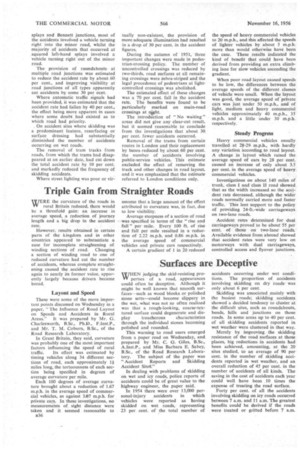Rebuilding for Safety
Page 69

Page 70

If you've noticed an error in this article please click here to report it so we can fix it.
THE overall effect of converting
normal crossroad layouts to one of staggered pattern was probably to decrease the accident rate by some 85 per cent. Reconstructing existing roads on new lines—to reduce curvature and gradients—was likely to cut down 'accidents by about 100 per cent. But to rebuild roads on the same,line to relieve congestion and improve traffic flow was estimated to raise the accident rate by some 120 per cent.
These were some of the more notable findings of a paper, "Accident Studies Before and After Road Changes," read on Wednesday. The paper was prepared by Mr, F. Garwood, M.A., Ph.D., F.S.S., and Mr. J. C. Tanner, M.A., F.8.5., of the Road Research Laboratory.
By providing dual carriageways, where two-way roads existed previously, accidents appeared to be reduced by up to 30 per cent., and improvement of the alignment at bends had probably caused the accident rate to drop by 70 per cent.
Other changes at bends, such as the provision of "Slow " signs on the carriageway and the lowering of hedges, might sometimes have prevented accidents and had the advantage of being cheap.
Where changes had been made to three-way junctions, incomplete data indicated that at squared right-hand u35 spfays and Bennett junctions, most of the accidents involved a vehicle turning right into the minor road, whilst the majority of accidents that occurred at squared left-hand splays involved a vehicle turning right out of the minor road.
The provision of roundabouts at multiple road junctions was estimated to reduce the accident rate by about 60 per cent., and improving visibility at road junctions of all types apparently cut accidents by some 30 per cent.
Where automatic traffic signals had been provided, it was estimated that the accident rate had fallen by 40 per cent., the effect being more apparent in cases where some doubt had existed as to which road had priority.
. On accident sites where skidding was a predominant feature, resurfacing or surface dressing had substantially diminished the number of accidents occurring on wet roads.
The removal of tram tracks from roads, from which the trams had disappeared at an earlier date, had cut down the total accident rate by 10 per cent. and markedly reduced the frequency of skidding accidents.
Where street lighting was poor or vir tually non-existent, the provision of more adequate illumination had resulted in a drop of 30 per cent. in the accident figures.
During the autumn of 1951, three important changes were made in pedestrian-crossing policy. The number of uncontrolled crossings was reduced by two-thirds, road surfaces at all remaining crossings were zebra-striped and the Legal precedence of pedestrians at lightcontrolled crossings was abolished.
The estimated effect of these changes was a 70 per cent. fall in the accident rate. The benefits were found to be particularly marked on main-road crossings at *ht. The introduction of " No waiting" areas did not give any clear-cut result, but it seemed reasonable to conclude from the investigations that about 30 per cent. fewer accidents occurred.
Removal of the trams from certain routes in London and their replacement by buses. reduced by about 60 per cent. the number of accidents involving public-service vehicles. This estimate excluded the effect of removing the track and other changes in road layout, and it was emphasized that the estimate referred to London conditions only.




















































































































